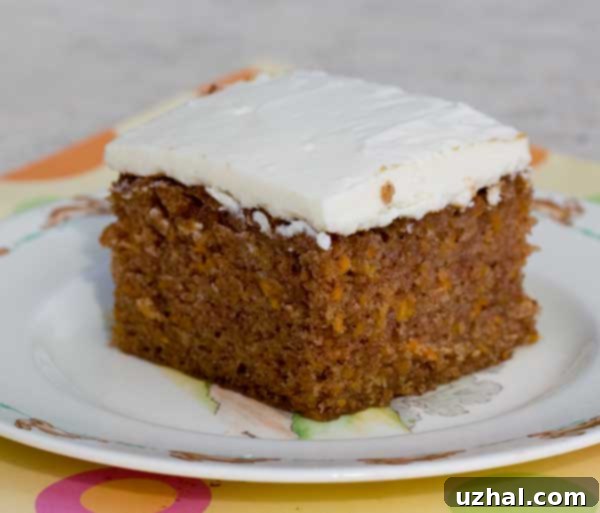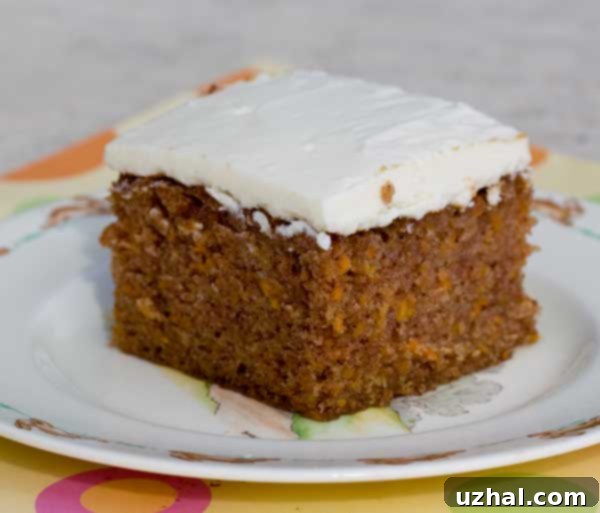The Ultimate Glass Dish Carrot Cake: Achieve Deep Color, Unbeatable Moisture & Perfect Texture
If you’re searching for an extraordinary carrot cake recipe, look no further than this exceptional version baked in a glass dish. This particular recipe consistently outperforms others in side-by-side taste tests, delivering a truly remarkable dessert. What makes it stand out? It boasts a wonderfully tight, yet light, crumb and a satisfyingly thick, tall profile, thanks to the specific baking vessel. But the most striking characteristic is its deep, dark brown hue—a feature we attribute primarily to the generous use of baking soda, transforming the appearance and enhancing the flavor profile of this classic treat.
Initially, using a full tablespoon of baking soda in a single recipe might raise an eyebrow. Many bakers, including myself, have concerns about a potential lingering aftertaste. Some palates are more sensitive to it than others. For me, a subtle sensation can sometimes remain on the tongue, though whether it’s pleasant or not largely depends on the ingredients it’s paired with. Interestingly, I’ve found that the distinctive aftertaste of baking soda works surprisingly well in certain contexts, such as the spicy kick of ginger cookies. And, as this recipe triumphantly proves, it creates a harmonious balance within a well-made carrot cake, contributing to its unique appeal rather than detracting from it.
The Science of Deep Color: Baking Soda’s Role in a Browner Carrot Cake
Beyond taste, baking soda plays a pivotal role in achieving the beautiful, rich brown color of this carrot cake. This phenomenon became clear during a comparative baking experiment. After perfecting this recipe, I prepared a half-batch version of a nearly identical carrot cake. The key difference? The second batch utilized only one teaspoon of baking soda combined with some baking powder and also incorporated brown sugar, which many assume is responsible for darker cakes. However, even with the addition of brown sugar, the cake lacked the profound brown depth seen in our original. This led to a crucial realization: it is the baking soda, not solely the brown sugar, that is the primary catalyst for the browner color in carrot cakes.
This insight isn’t exclusive to carrot cakes. I first noticed this effect when developing a recipe for banana bread baked at a low temperature. That particular recipe calls for over a tablespoon of baking soda, and the resulting loaf consistently bakes to an incredibly dark, almost caramelized shade. The alkalinity introduced by baking soda significantly enhances the Maillard reaction—a chemical process between amino acids and reducing sugars that gives browned food its distinctive flavor and color. This reaction is intensified in an alkaline environment, leading to a much richer, darker crust and crumb than you would achieve with a more acidic or neutral batter, regardless of the presence of brown sugar.
Beyond Color: How Baking Soda Elevates Carrot Cake Moisture and Texture
The magic of baking soda extends beyond just color; it fundamentally transforms the texture and moisture of the carrot cake. This is where the chemistry truly shines. Baking soda reacts with acidic ingredients in the batter (like buttermilk, which this recipe includes) to produce carbon dioxide gas, causing the cake to rise. However, its alkalinity also interacts uniquely with the carrots themselves. As noted by culinary experts like Cook’s Illustrated, the alkaline environment created by baking soda helps to break down the tough cellulose walls within the shredded carrots. This breakdown is crucial because it allows the carrots to release their inherent moisture more effectively into the batter as the cake bakes.
The result of this chemical process is a profoundly moister cake, where the carrots are not merely suspended but are more thoroughly integrated into the overall structure. Instead of distinct, fibrous pieces, the carrots become softer and contribute to the cake’s tenderness and cohesive texture. In contrast, using baking powder, which is typically a mix of an alkaline compound and an acid, tends to produce a less alkaline environment and thus often leads to a flakier, lighter crumb but doesn’t offer the same breakdown of vegetable fibers. For a carrot cake where the carrots truly meld into the moist, flavorful matrix, baking soda is an indispensable ingredient, delivering a harmonious blend of sweetness, spice, and tender vegetable goodness.
The Glass Dish Advantage: Achieving a Taller, More Evenly Baked Cake
While metal pans are often the go-to for many bakers, using a glass dish for this carrot cake offers distinct advantages, particularly for aesthetics and specific texture outcomes. My usual preference for baking cakes leans towards metal pans due to their efficient heat conduction. However, for certain recipes, especially when presentation matters or a particular cake profile is desired, a glass dish is my chosen vessel. For instance, the common 9×13 inch metal pan produces a standard sheet cake. But for this carrot cake, I intentionally sought a slightly taller, more substantial slice, which led me to bake it in an 8×12 inch glass dish.
Baking in glass requires a slight adjustment to your technique, primarily with oven temperature. Glass dishes conduct heat differently than metal. They absorb heat more slowly but retain it for longer and distribute it more intensely once heated through. To compensate for this and ensure a more even bake without overly browning the edges or bottom, it’s generally recommended to reduce the oven temperature by 25 degrees Fahrenheit when using glass instead of metal. So, for a recipe that might call for 350°F in a metal pan, I bake this cake at 325°F in the glass dish. While I usually adhere to this rule, I admit that sometimes I forget to lower the heat when switching to glass. In such instances, the cake still turns out well, though I might notice slightly chewier or browner edges, which isn’t always a negative, depending on personal preference. This minor adjustment ensures that the cake cooks uniformly from the center outwards, preventing a dry exterior while the interior remains underbaked.
Choosing the right baking vessel is crucial for the final outcome. The inherent properties of glass allow the cake to develop a beautiful crust and a consistently moist interior. The smaller, deeper dimensions of the 8×12 inch glass dish force the cake batter to rise higher, resulting in those appealing thick slices that were initially praised. This makes the cake feel more substantial and indulgent, perfectly complementing its rich color and tender crumb. When planning your next baking adventure, consider the nuanced impact of your bakeware—it truly can make a significant difference in the success and enjoyment of your homemade desserts, especially with a recipe as thoughtfully designed as this one.
- Greek Yogurt Brownies with Self-Rising Flour
- Buttermilk Marble Cake Baked in a 9×13 inch Pan
- Glass Dish Brownies
- Chocolate Carrot Brownies
- Two Layer Carrot Cake
Recipe

Exceptional Carrot Cake Baked in an 8×12 Inch Glass Dish
Anna
Pin Recipe
Ingredients
- 2 cups all-purpose flour (approx. 9.8 oz/275 grams)
- 1 tablespoon baking soda
- 1 tablespoon ground cinnamon
- ¼ teaspoon kosher salt (scant), Morton brand recommended
- 1 cup vegetable oil or grapeseed oil
- 2 cups granulated sugar
- ½ cup buttermilk
- 3 large eggs
- 2 tablespoons mayonnaise (alternatively, use an additional egg for similar results)
- 1 teaspoon vanilla extract
- 2 cups grated carrots (approx. 10 oz or 280 grams), or shredded and finely chopped
Cream Cheese Frosting
- 8 ounces cream cheese (softened to room temperature)
- 2 ounces unsalted butter (softened to room temperature)
- 1 cup powdered sugar
- 1 teaspoon vanilla extract
Instructions
-
Preheat your oven to 325 degrees F (160°C). Lightly grease an 8 x 12 inch glass baking dish, ensuring all surfaces are covered to prevent sticking.
-
In a large mixing bowl, thoroughly combine the dry ingredients: all-purpose flour, baking soda, ground cinnamon, and kosher salt. Whisk them together until well-blended and uniform.
-
In a separate, second mixing bowl, whisk together the wet ingredients: vegetable or grapeseed oil, granulated sugar, buttermilk, large eggs, mayonnaise (or extra egg), and vanilla extract. Beat until smooth and well-incorporated.
-
Gradually add the dry ingredients mixture to the wet ingredients. Stir gently using a spatula or wooden spoon until just combined, being careful not to overmix. Once combined, fold in the grated carrots until evenly distributed throughout the batter.
-
Pour the prepared carrot cake batter into the greased 8×12 inch glass pan. Bake for 45 to 50 minutes, or until a wooden skewer or toothpick inserted into the center comes out clean. During baking, observe the cake’s color transition from orange to a deep, rich brown. Remove from oven and let the cake cool completely in the pan on a wire rack before attempting to frost it.
-
To prepare the luscious cream cheese frosting: In a mixing bowl, beat the softened cream cheese and butter together until the mixture is light, fluffy, and completely smooth. Gradually add the powdered sugar, mixing until fully incorporated and creamy. Finally, beat in the vanilla extract until the frosting is smooth and spreadable. Once the cake is completely cooled, generously spread the cream cheese frosting evenly over the top.
Notes
This glass dish carrot cake truly offers a baking experience that yields exceptional results, from its enticing dark color to its incredibly moist and tender crumb. By understanding the unique interactions of ingredients like baking soda and the characteristics of your bakeware, you can consistently achieve professional-quality desserts in your home kitchen. Enjoy the rich flavors and delightful texture of this elevated classic!
